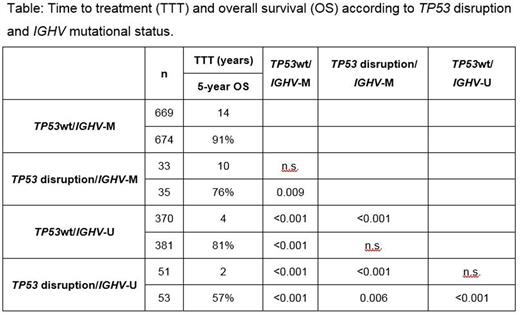Abstract
Background: Treatment-naive CLL patients displaying TP53 disruption (TP53 mutation and/or del(17p)) show heterogeneity in their clinical course. A few studies have proposed a mutated IGHV status and Rai 0 as potential factors for an indolent disease course in these cases.
Aim: To determine the prognostic impact of TP53 disruption in a treatment-naive CLL cohort and the factors associated with an indolent disease course.
Patients and Methods: 1,327 CLL patients at diagnosis or without prior treatment were screened both for TP53 mutations (mut) and del(17p). IGHV mutational status was analyzed in all cases. IGHV mutated status (IGHV-M) was defined by sequence identity <98%. Chromosome banding analysis and interphase FISH with probes for 13q14, 11q22 and centromeric region of chromosome 12 were performed in all cases. Additionally, data on mutations in SF3B1 (n=1,183) and NOTCH1 (n=967) was present. Male:female ratio was 2:1 and median age was 67 years (range: 30 - 91 years). Data on Binet stage was available in 711 cases. Follow-up data on time to first treatment (TTT) and overall survival (OS) was available in 1,123 (TP53 disruption: 84) and 1,143 (TP53 disruption: 88) cases, respectively, with a median follow-up of 6 years, each.
Results: Overall in 7% (97/1,327) of patients a TP53 disruption was present. TP53mut was detected in 89 (7%) of cases and del(17p) in 51 (4%). Three different combinations were determined: TP53mut with del(17p) in 43 (44%) cases, TP53mut sole in 46 (48%) patients and del(17p) sole in 8 (8%) cases. TP53 disruption was associated with IGHV-U vs. IGHV-M (12% vs. 5%, p<0.001), NOTCH1mut vs. NOTCH1wt (14% vs. 8%, p=0.027), complex karyotype (≥ 3 abnormalities) vs. non-complex karyotype (27% vs. 6%, p<0.001), and Binet B/C vs. A (10% vs. 5%, p=0.010). In contrast, TP53 disruption was rare in del(11q) vs. others (3% vs. 8%, p=0.046).
Next, we analyzed patients with TP53 disruption for differences in TTT and OS according to IGHV mutational status, SF3B1mut, NOTCH1mut, del(11q), trisomy 12, del(13q), complex karyotype and Binet stage. We detected a significantly longer TTT in IGHV-M cases (median: 10 vs. 2 years, p<0.001) and in patients without trisomy 12 (median: 6 vs. 2 years, p=0.046). A better 5-year OS was seen in cases with IGHV-M (76% vs. 57%, p=0.006) and in patients with Binet A vs. B/C (80% vs. 46%, p=0.049). Interestingly, in TP53 disruption/IGHV-M patients as compared to IGHV-M without TP53 disruption no significant difference in TTT was detected. In contrast, TP53 disruption/IGHV-M cases showed an intermediate 5-year OS comparable to IGHV-U without TP53 disruption, whereas patients with IGHV-U/TP53 disruption showed the most adverse OS (see Table). A cox regression analysis in TP53 disrupted cases including all the above mentioned factors showed significant impact only for IGHV-M both on TTT (HR: 0.24, p<0.001) and OS (HR: 0.38, p=0.008).
Therefore, we further focused on the characterization of patients with TP53 disruption/IGHV-M vs. TP53 disruption/IGHV-U. TP53 disruption/IGHV-M showed higher frequencies of del(13q) (71% vs. 45%, p=0.013), whereas del(17p) (39% vs. 63%, p=0.025) and trisomy 12 (2% vs. 23%, p=0.003) were less frequent. NOTCH1mut were mutually exclusive of TP53 disruption/IGHV-M (0% vs. 36%, p<0.001). Thus, within the cohort of TP53 disruption cases the subgroup with IGHV-M is characterized by the occurrence of adverse prognostic factors to a lesser extent.
Conclusions: Treatment-naive patients with TP53 disruption and IGHV-M show a more indolent disease course: (1) TTT was not significantly altered in comparison to IGHV-M cases without TP53 disruption; (2) for OS an additive effect of IGHV-U and TP53 disruption was detected with patients presenting with both factors showing the most adverse OS. Thus, in treatment-naive CLL patients TP53 disruption should always be evaluated on the background of IGHV mutational status and as recommended only at progression and before treatment is required.
Jeromin:MLL Munich Leukemia Laboratory: Employment. Haferlach:MLL Munich Leukemia Laboratory: Employment, Equity Ownership. Dicker:Munich Leukemia Laboratory: Employment. Haferlach:MLL Munich Leukemia Laboratory: Employment, Equity Ownership. Kern:MLL Munich Leukemia Laboratory: Employment, Equity Ownership.
Author notes
Asterisk with author names denotes non-ASH members.


This feature is available to Subscribers Only
Sign In or Create an Account Close Modal